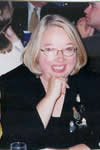
Dixon 1981b
“Bosch’s Garden of Delights Triptych: Remnants of a ‘Fossil’ Science” (Laurinda S. Dixon) 1981
[in: The Art Bulletin, 63 (1981), pp. 96-113]
[Also mentioned in Gibson 1983: 87-88 (E89)]
This article is based on Dixon’s dissertation (see Dixon 1980). In order to understand the symbolic imagery of Bosch’s Garden of Delights triptych we lack the vocabulary that was available to Bosch’s patrons and public. According to Dixon the key to Bosch’s symbolism can be found in alchemy. Earlier authors (i.a. Van Lennep, Combe, Bergman) have already related Bosch to alchemy but their approach was not appropriate because they did not recognize the great differences between early alchemy and its later mutation, Rosicrucianism and also because they ignored the practical aspects of alchemy, in particular the distillation of medicines. When we relate alchemy to Bosch, we have to look at alchemy objectively from a fifteenth-century perspective and compare only the early (and not the later) elements to Bosch’s works.
Dixon first points out that there was a pharmacist in the family of Bosch’s wife. In a footnote we read that this was the grandfather of Bosch’s wife. But in the actual text of the article pharmacy has suddenly become ‘the family profession of Bosch’s in-laws’: this could be called ‘jumping to conclusions’. Dixon further signals that alchemy was not an occult and generally disapproved science: pharmacists and doctors used it and many people (popes, kings and scholars, one of them Paracelsus) had a high opinion of it. It was common practice, though, to provide alchemical texts and images with a symbolic code lest the information would fall into wrong hands. Because of this fifteenth-century alchemical texts often had an esoteric character and they are often obtuse and contradictory. Dixon then repeats her major 1980 thesis: the left interior panel, central panel, right interior panel and exterior panels of the Garden of Delights represent the four steps of the alchemical work (coniunctio, coagulatio, putrificatio, purificatio). In this article she limits herself to the identification of distillation apparatus in the Garden.
At the beginning of her article Dixon points out: ‘It would be impossible to prove that Bosch saw and copied intact a particular alchemical image in his paintings’. Some pages further she writes: ‘Bosch’s triptych is puntuated by forms and shapes which on the surface appear as mere flights of fancy, unless compared with diagrams found in distillation texts’. It has to be admitted that more than once the examples presented in this article and the alchemical images to which some of Bosch’s motifs are compared seem to be convincing. Remarkable, for instance, is the similarity between the central blue fountain (central panel, background) and the transparent sphere-with-couple (central panel, lower left) and an alchemical ‘marriage chamber’ (see illustration 9). The colon topped by a glass sphere-with-bumps (central panel, lower right corner) does indeed look like a bain-marie (see illustrations 17 and 18). Dixon further signals glass retorts, headgears that look like transparent funnels and the rounded transparent bowl (central panel, foreground) covering three persons that looks like a steam bath (see illustration 27). It is interesting that Dixon points out that none of these objects fulfil their original function in Bosch’s painting, they are just being used as ‘toys’ for the ‘children of Adam and Eve’ (a supposed reference to one of the steps of the alchemical work known as ‘child’s play’).
The numerous birds and peculiar rock formations in the upper left interior panel are related, again: not unconvincingly, to gases that become cleansed during the distillation process and to alchemical furnaces and flasks. In alchemy the ovoid vessel in which all ingredients are combined and transmuted, is called ‘egg’. Dixon relates this to a number of eggs in the Garden, in particular to the ovoid body of the so-called Tree-man in the right interior panel. The large bagpipe atop his head is said to refer to a cornamuse, an alchemical apparatus that looked like a bagpipe (which explains its name). The fact that Bosch painted these objects in hell is explained by relating them to the stage of putrefaction (putrificatio), which was influenced by the planet Saturn. The way in which she relates the exterior panels to the ablutio stage (the stage of cleansing and purification) seems less convincing.
In an appendix Dixon offers a survey of alchemical books printed between 1460 and 1515 that Bosch may have known.
Dixon’s interpretations seem to signal that alchemy does indeed play a part in Bosch’s Garden of Delights. Many details, which otherwise cannot be explained, seem to be inspired by alchemical laboratory apparatus. But that Bosch would have hidden a complete alchemical programme in his triptych, seems less probable. Dixon herself says that the objects looking like alchemical apparatus don’t fulfil their actual (alchemical) function and when she does recognize alchemical functions in the painting her argument becomes confusing and little convincing. That Bosch used alchemy as a ‘trigger’ for his imagination seems very plausible. Nevertheless, Bosch does not display a profound knowledge of alchemy and its complex processes. The question then remains: did Bosch have a special intention with the (albeit superficial) references to alchemy in his triptych?
[explicit 31st July 2011]